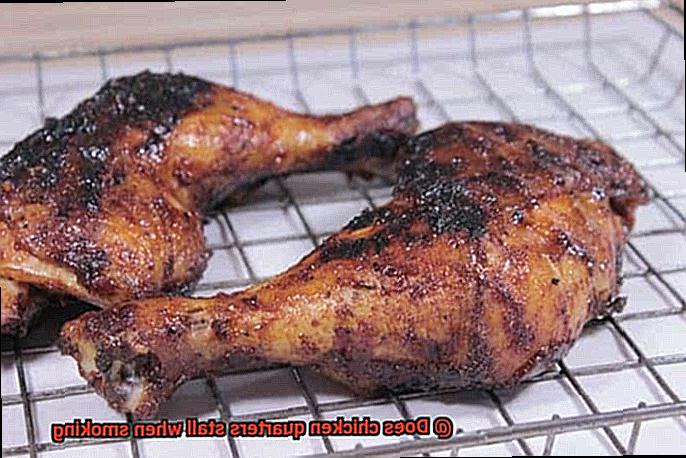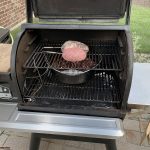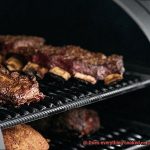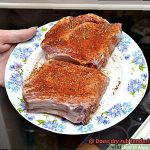Imagine a warm, sunny day, surrounded by friends and family while the delicious aroma of smoked chicken fills the air. Smoking chicken quarters is a beloved method of cooking that many people enjoy during their outdoor barbeque sessions. However, there’s one common issue that often arises during the process: the stall.
The stall can be a frustrating and confusing experience for both novice and experienced smokers alike. It’s when meat takes longer to cook than expected, leaving you wondering if your chicken quarters will ever reach the perfect temperature. This begs the question: does chicken quarters stall when smoking?
In this blog post, we’ll take a deep dive into the world of smoking chicken quarters and explore whether or not the stall is a common occurrence. We’ll discuss the science behind it and all the factors that contribute to it when smoking chicken quarters. Plus, we’ll share some tips and tricks on how to avoid this pesky problem so you can ensure that your chicken quarters are cooked to perfection every time.
So whether you’re an expert smoker or just starting out in this flavorful journey, this blog post is sure to provide valuable insights to improve your smoking game. Let’s get started.
Contents
What is Stalling in Smoking Chicken Quarters?
Smoking chicken quarters is a time-honored tradition that requires patience, skill, and a little bit of know-how. However, it can be frustrating when the internal temperature of the meat plateaus during cooking, a phenomenon that is known as stalling.
Stalling typically occurs when the chicken reaches an internal temperature of around 150-160 degrees Fahrenheit. At this point, moisture inside the meat starts to evaporate, which has a cooling effect that slows down the cooking process. This can be particularly frustrating for grillers who are trying to plan their cooking time and ensure that their chicken is fully cooked.
Several factors can contribute to stalling in smoking chicken quarters. One of the most common causes is the presence of collagen in the meat, which takes time to break down into gelatin. Additionally, the surface area of the chicken quarters can also slow down the cooking process if they are placed on the grill with the skin side up.
Fortunately, there are several ways to mitigate stalling when smoking chicken quarters. One option is to wrap the chicken in foil or butcher paper once it reaches an internal temperature of around 150-160 degrees Fahrenheit. This will help trap in moisture and prevent further evaporation, allowing the chicken to continue cooking at a more consistent rate. Another option is to start the chicken at a higher temperature and then lower it later in the cooking process.
It’s important to note that stalling can also occur when smoking other types of meat, such as pork shoulder or brisket, but the timing and duration of stalling may vary depending on the type of meat you’re smoking and your cooking technique.
Causes of Stalling When Smoking Chicken Quarters
It can be a frustrating experience when the internal temperature of your meat reaches a certain point and then seems to plateau or even decrease for an extended period.
Let me break down the causes of stalling when smoking chicken quarters and provide you with some tips to prevent it from happening.
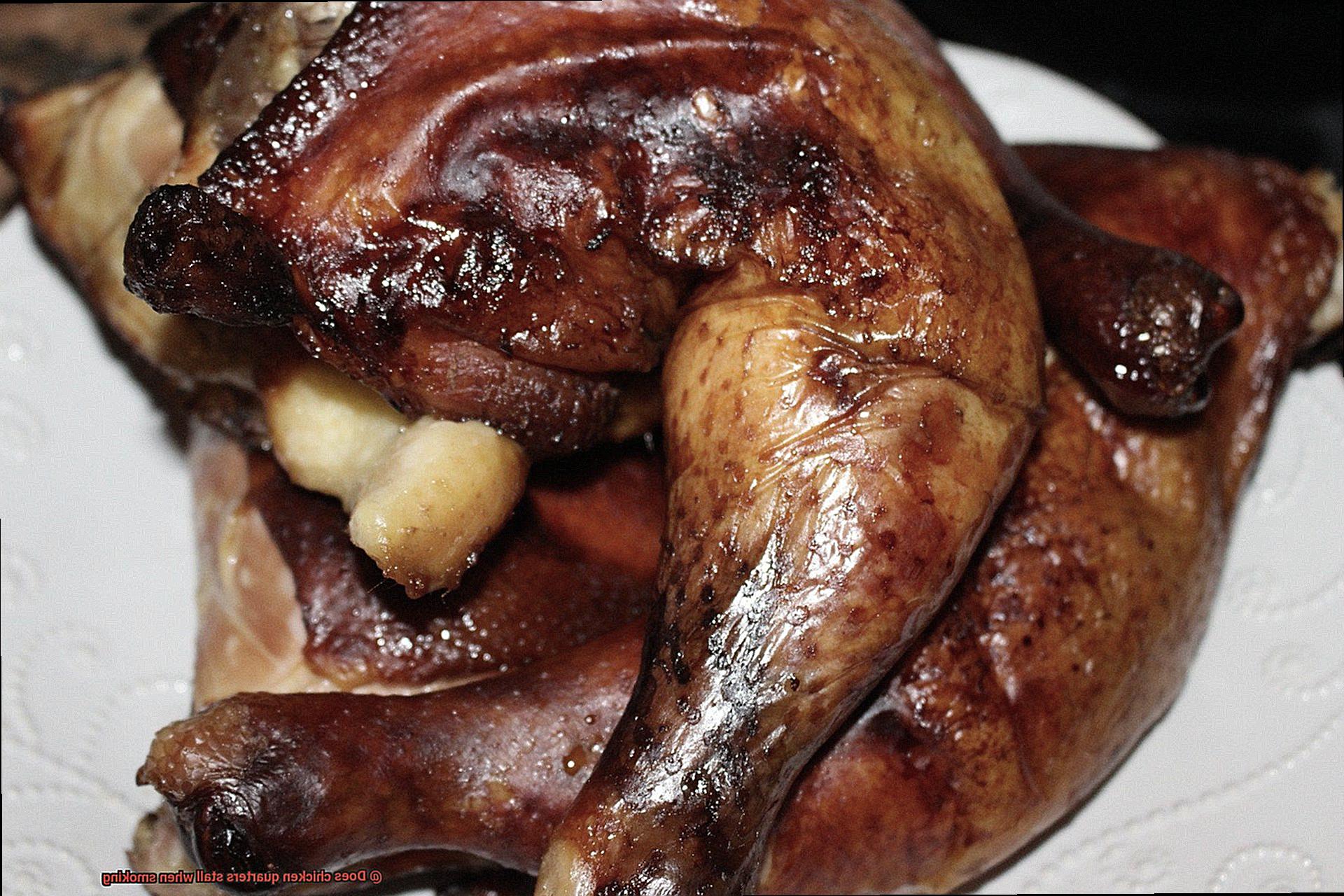
One of the most common causes of stalling is evaporation. As moisture evaporates from the meat’s surface, it cools the surface, causing the temperature to plateau or even decrease. This can be due to insufficient moisture levels, so keep an eye on the meat’s moisture content throughout the cooking process.
Another culprit behind stalling is collagen breakdown. Collagen is a connective tissue found in meat that surrounds muscle fibers. When it breaks down during cooking, it releases liquid that can cool the surface of the meat and cause stalling. To prevent this, make sure to cook your chicken quarters at a consistent temperature and monitor their internal temperature closely.
Temperature fluctuations during cooking can also be a cause of stalling. If your smoker’s temperature is too low or if there are fluctuations in temperature, it can take longer for the meat to reach its target temperature, increasing the likelihood of stalling. To avoid this, use a reliable thermometer to monitor your smoker’s temperature and adjust it as needed.
The size and shape of your chicken quarters can also influence stalling. Larger pieces of meat may take longer to cook and reach their target temperature, which can increase the likelihood of stalling. To prevent this, try to cut your chicken quarters into similarly sized portions before smoking them.
To prevent stalling when smoking chicken quarters, wrap them in foil during cooking to reduce moisture loss and promote more even heating. And finally, make sure to let your meat rest for a few minutes after cooking to allow any remaining collagen to break down and redistribute moisture throughout the meat.
Impact of Collagen on Smoking Chicken Quarters
Understanding the impact of collagen on smoking chicken quarters can help you achieve perfectly cooked and tender meat every time.
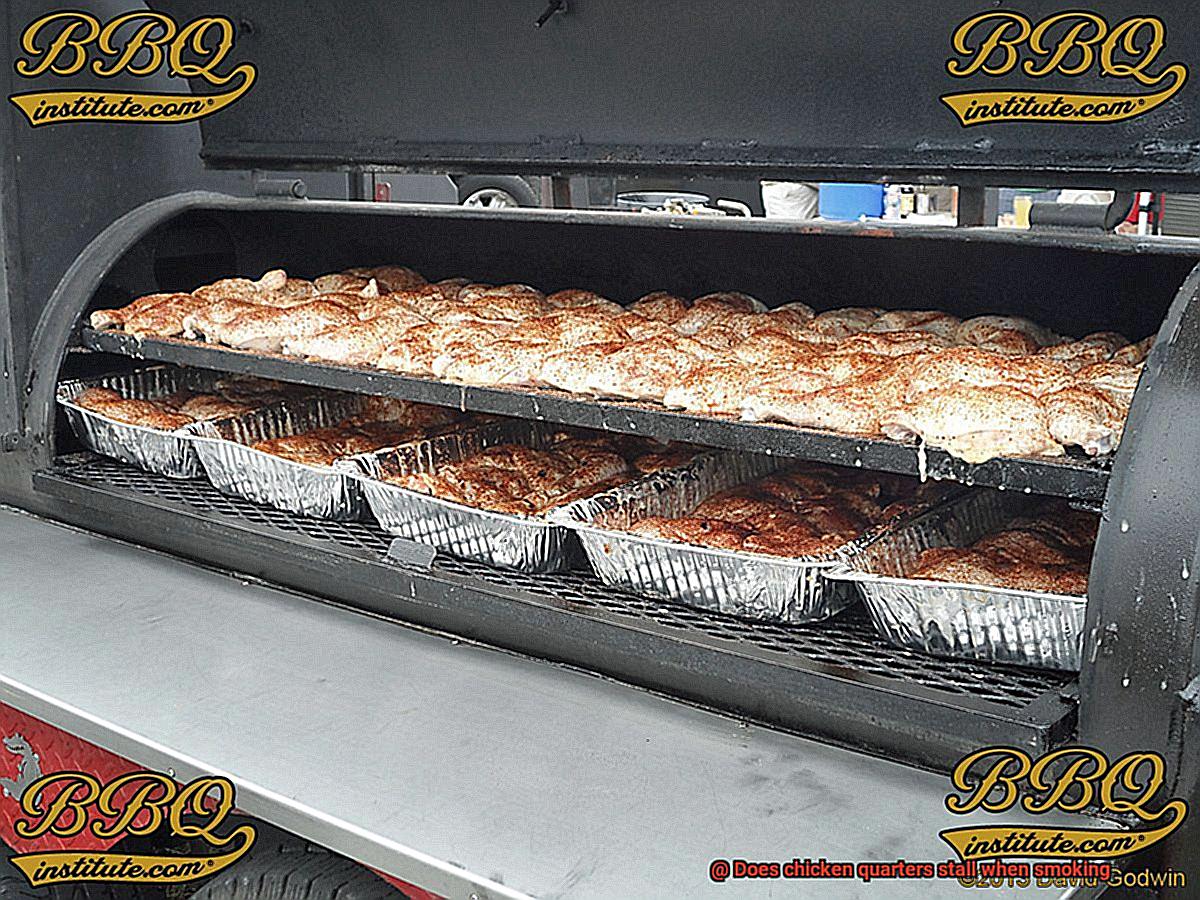
Collagen is a protein found in connective tissue that plays a vital role in the texture and tenderness of meat. When smoking chicken quarters, collagen begins to break down and convert into gelatin, which helps keep the meat moist and tender. However, this breakdown process can also cause the chicken to stall during cooking.
The stall occurs when the temperature of the meat plateaus for an extended period, causing frustration for those trying to cook their chicken quarters to perfection. This happens because the gelatin absorbs moisture, leading to evaporation and cooling on the surface of the meat.
There are several techniques to combat this stall. One method is called the “Texas Crutch,” which involves wrapping the chicken quarters in foil or butcher paper to trap moisture and heat, speeding up the cooking process. However, some argue that this method can lead to steaming rather than smoking, resulting in a loss of flavor.
Another way to adjust cooking times and temperatures is by using different equipment or adjusting personal preferences. By monitoring temperature and using these techniques, you can achieve perfectly cooked and tender chicken quarters without sacrificing flavor.
It’s essential to understand the impact of collagen on smoking chicken quarters and how it affects cooking times and techniques. By doing so, you’re better equipped to make informed decisions about your smoking process.
Impact of Surface Area on Smoking Chicken Quarters
As an expert in the field, I can tell you that the surface area of your meat plays a crucial role in determining whether or not it stalls. Allow me to break it down for you.
Chicken quarters with a larger surface area tend to stall more frequently than those with a smaller surface area. This is because the larger surface area allows for more moisture to evaporate from the meat, which in turn causes the temperature to plateau. But don’t fret. There are ways to combat this issue.
Managing the temperature and humidity levels during the smoking process is key. Consistent temperature and enough moisture in the smoking chamber can help prevent your chicken quarters from stalling. Remember, it’s all about balance.
Another technique that some smokers swear by is the “Texas Crutch.” This involves wrapping your chicken quarters in foil or butcher paper during the smoking process to help retain moisture and prevent stalling. However, be aware that this method may result in a softer, less crisp skin on your chicken.
Now that you know how to prevent stalling, let’s talk about achieving perfectly cooked and juicy smoked chicken quarters. It’s all about experimentation. Try different techniques like the Texas Crutch and adjust your temperature and humidity levels until you find what works best for you.
Techniques for Avoiding Stalling When Smoking Chicken Quarters
Smoking chicken quarters can be a delectable experience, but stalling can be a frustrating aspect of the process. Luckily, there are techniques that you can use to avoid this issue and achieve perfectly cooked, juicy meat every time.
To begin with, maintaining a consistent temperature throughout the cooking process is crucial. You can achieve this by using a digital thermometer to monitor the smoker’s temperature and make adjustments accordingly. This will ensure that your chicken quarters cook evenly and avoid stalling.
Another technique is to use a water pan in the smoker. The water will help regulate the temperature, add moisture to the meat, and prevent stalling. This is particularly helpful when cooking chicken quarters as they tend to dry out quickly.
For those who want to take their smoking game to the next level, try using the Texas Crutch method. This involves wrapping your chicken quarters tightly in foil or butcher paper once they reach a certain temperature. This method speeds up the cooking process and prevents stalling, resulting in perfectly cooked meat every time.
Lastly, don’t forget to let your chicken quarters rest for 10-15 minutes after they come off the smoker. This allows the juices to redistribute throughout the meat, ensuring that it stays moist and flavorful.
Wrapping the Chicken in Foil
Smoking chicken quarters is a culinary adventure that can often lead to dry and tough meat. But fear not, as an expert in smoking chicken, I have the perfect solution to ensure that your meat stays moist and tender throughout the cooking process: wrapping the chicken in foil.
Why is this technique so beneficial? The aluminum foil traps in the moisture, preventing it from evaporating during the smoking process. This means that each bite of your chicken will be bursting with juicy and savory goodness.
To wrap your chicken in foil, start by seasoning the meat with your preferred spices and herbs. Next, lay out a sheet of aluminum foil that is large enough to fully encase the chicken quarters. Place your seasoned chicken onto the foil and wrap it tightly, making sure to seal all of the seams to prevent steam from escaping.
While wrapping your chicken in foil may extend the cooking time due to its barrier properties, this technique can be especially helpful when smoking tougher cuts of meat like chicken quarters. The slower and more even cooking process allows for a more tender and flavorful end product.
It’s important to note that monitoring the internal temperature with a meat thermometer is crucial. The chicken should reach an internal temperature of 165°F to ensure that it is fully cooked and safe to eat.
In summary, wrapping chicken quarters in foil when smoking is an effective technique for ensuring juicy and flavorful meat. To make things easier, here are some steps to follow:
- Season the chicken with your preferred spices and herbs.
- Lay out a sheet of aluminum foil large enough to fully encase the chicken.
- Place the seasoned chicken onto the foil.
- Wrap the chicken tightly, making sure all seams are sealed.
- Monitor the internal temperature with a meat thermometer.
- Enjoy your deliciously tender and juicy smoked chicken.
Starting the Cooking Process at a Higher Temperature
When smoking chicken quarters, it’s important to remember that they are a larger cut of meat and can take longer to cook than other cuts of chicken. This means that the chicken can linger in the danger zone for bacteria growth, which increases the risk of foodborne illness. But fear not, starting the cooking process at a higher temperature can reduce this risk by quickly getting the chicken up to a safe temperature without sacrificing flavor.
The key to this technique is searing the chicken quarters at high heat. Not only does this create a deliciously crispy crust on the outside of the meat, but it also quickly brings it up to a safe temperature. Once seared, simply move the chicken quarters to a cooler part of your smoker or grill and cook them low and slow until reaching an internal temperature of 165°F – which is considered safe for consumption.
But wait, there’s more. Here are some additional benefits and tips for starting the cooking process at a higher temperature:
- It helps to seal in moisture and prevent dryness in your chicken quarters.
- You can use this technique for other cuts of meat as well, such as pork or beef.
- Starting at a higher temperature does not mean cooking at a higher temperature throughout the entire cooking process. The goal is to quickly get your meat up to a safe temperature before lowering the heat for a slow and steady cook.
- Experiment with different seasoning blends or marinades to enhance the flavor of your smoked chicken.
- Consider using wood chips or chunks for added smoky flavor.
v6N4H_cIM98″ >
Conclusion
In conclusion, smoking chicken quarters is a time-honored tradition that requires patience, skill, and a bit of finesse. However, the notorious stall can be an infuriating experience for both novices and experienced smokers alike. The stall happens when the meat takes longer to cook than anticipated, leaving you questioning if your chicken quarters will ever reach their desired temperature. But don’t worry. There are several ways to avoid stalling when smoking chicken quarters.
One common culprit of stalling is collagen breakdown. Collagen is a connective tissue found in meat that encases muscle fibers. When it breaks down during cooking, it releases liquid that can cool the surface of the meat and cause stalling. To prevent this from happening, make sure to cook your chicken quarters at a consistent temperature and monitor their internal temperature closely.
Another way to avoid stalling is by wrapping your chicken in foil or butcher paper once it reaches an internal temperature of around 150-160 degrees Fahrenheit. This will help trap in moisture and prevent further evaporation, allowing the chicken to continue cooking at a more consistent rate.
Starting the cooking process at a higher temperature can also reduce the risk of bacteria growth while quickly getting your meat up to a safe temperature without sacrificing flavor.
By understanding the science behind smoking chicken quarters and all the factors that contribute to stalling, you’ll be able to achieve perfectly cooked and juicy smoked chicken every time.

